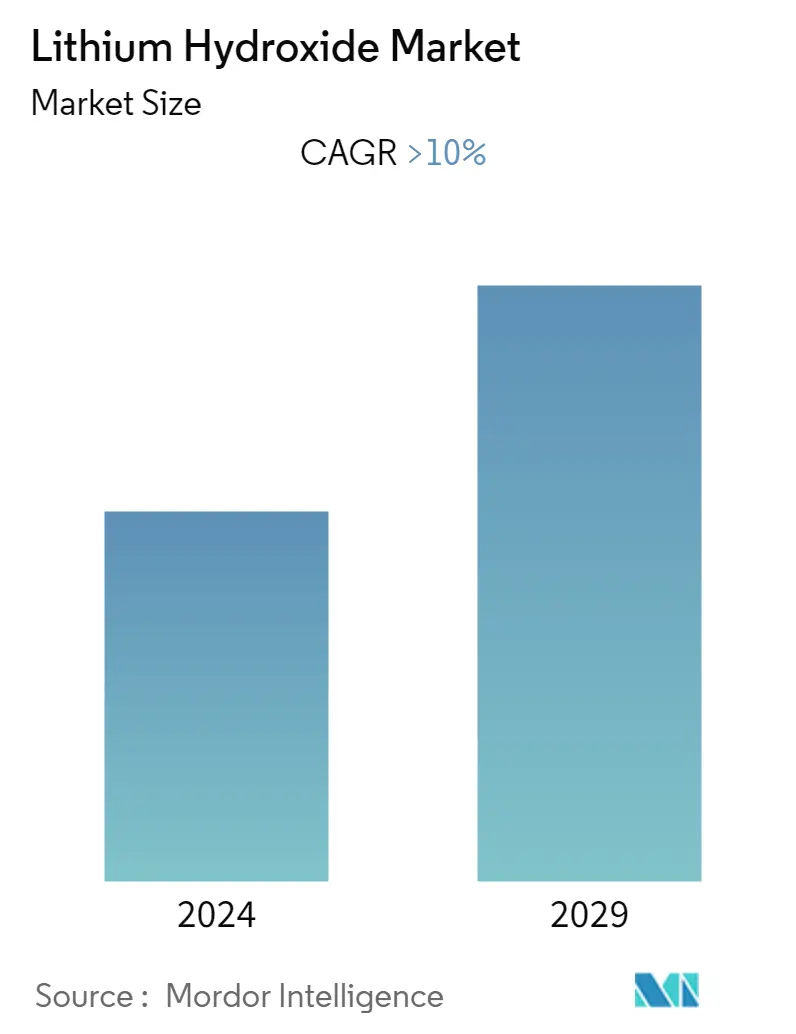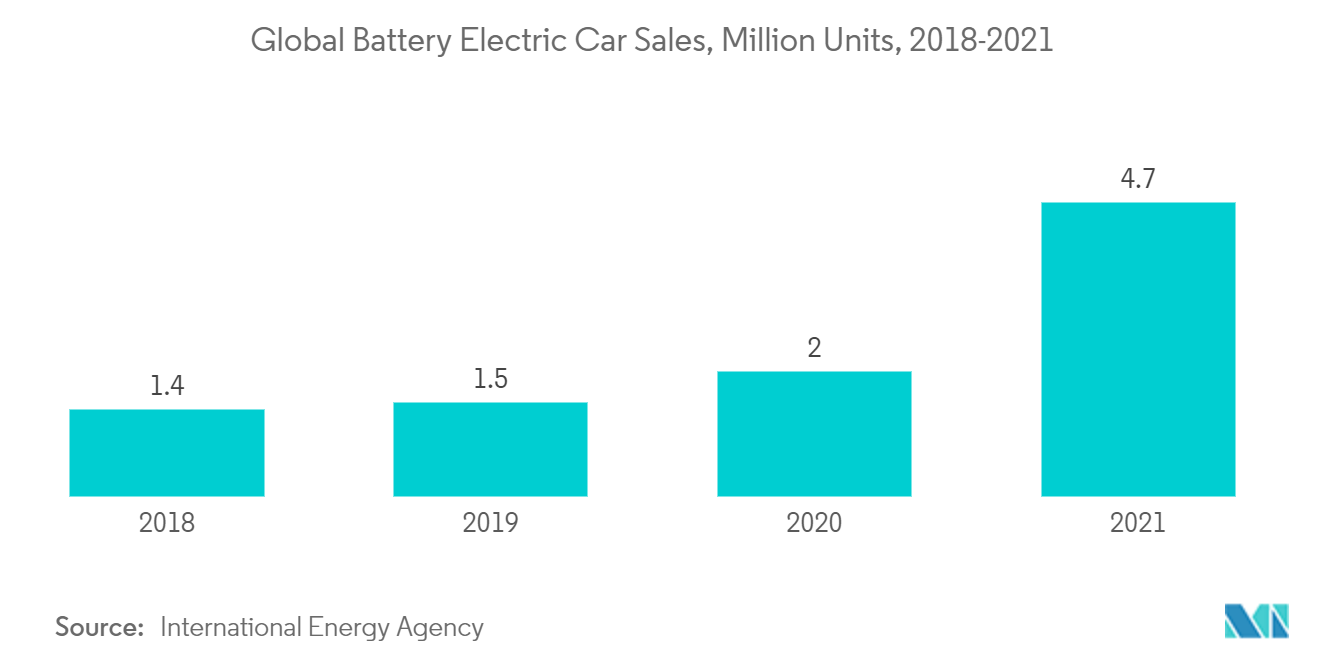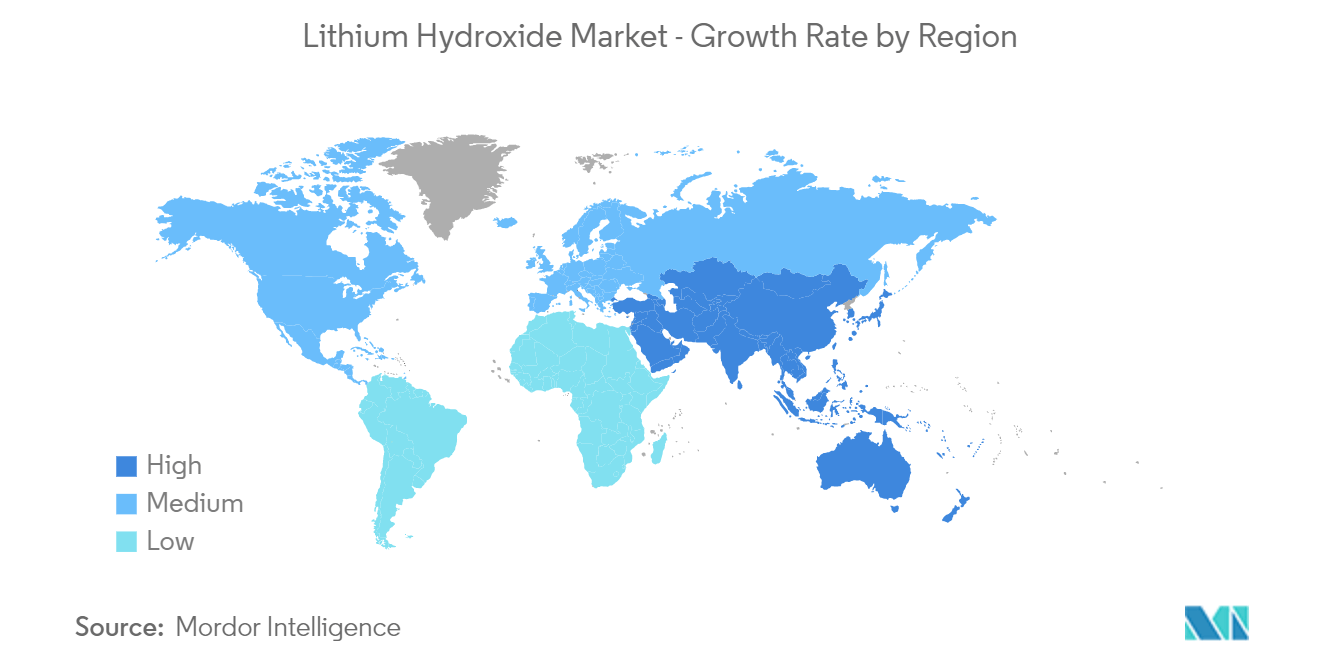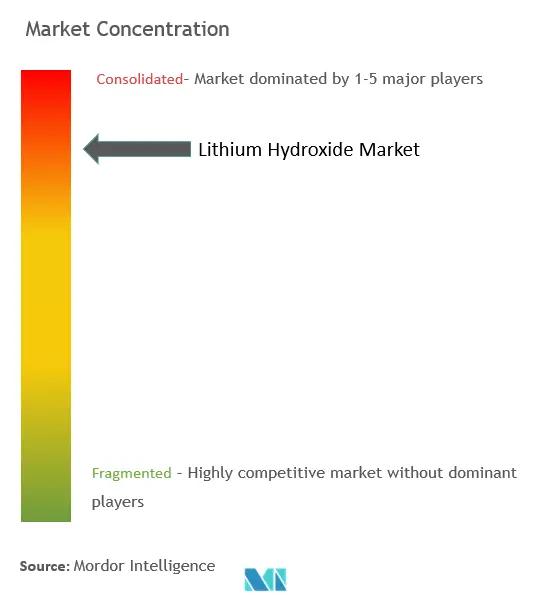Lithium Hydroxide Market Size

| Study Period | 2018 - 2028 |
| Base Year For Estimation | 2022 |
| CAGR | > 10.00 % |
| Fastest Growing Market | Asia Pacific |
| Largest Market | North America |
| Market Concentration | High |
Major Players*Disclaimer: Major Players sorted in no particular order |
Need a report that reflects how COVID-19 has impacted this market and its growth?
Lithium Hydroxide Market Analysis
The Lithium Hydroxide Market is expected to grow at a CAGR of over 10% during the forecast period.
COVID-19 impacted short-term lithium hydroxide sales. Early in the pandemic, lithium hydroxide demand fell, notably in the car and electronics sectors, due to supply chain delays and an economic slowdown. However, in 2021, the market recovered as renewable energy and energy storage became more essential, especially in the context of global greenhouse gas emission reduction and green energy efforts. Electric car and stationary energy storage lithium-ion battery spending grew.
- Major factors driving the market studied are the growing demand for electric vehicles that use lithium batteries and the increasing demand for power tools that use lithium hydroxide NCA cathode.
- However, rising concern regarding the toxicity of lithium hydroxide is expected to restrain the market's growth.
- The growing industrialization in Asia-Pacific is expected to drive the demand for power tools, which, in turn, will increase the demand for lithium hydroxide as the power tools use lithium hydroxide NCA cathode.
- Asia-Pacific dominated the market across the world with high demand from the EV sector.
Lithium Hydroxide Market Trends
Battery Application Segment to Dominate the Market
Lithium Hydroxide is a preferred compound for making cathodes in rechargeable batteries because it has a high electrochemical potential, which means it can produce a significant amount of electrical energy. It is lightweight, which is important for portable devices like electric vehicles. Lithium Hydroxide has good thermal stability and can improve the battery's overall performance, making it a popular choice for manufacturers.
Governments worldwide are promoting the growth of the electric vehicle market by offering generous subsidies and incentives to consumers who purchase electric vehicles and implementing stricter regulations on conventional vehicles. For example, China has been leading the charge in the electric vehicle market and aims to have more than 50% of all new car sales be electric vehicles by 2035. These government policies have played a significant role in driving the growth of the electric vehicle market.
The battery application segment of the global lithium hydroxide market refers to the use of lithium hydroxide in manufacturing cathode materials for lithium-ion batteries. Lithium-ion batteries are widely used in applications such as portable electronics, electric vehicles, and stationary energy storage systems. Lithium hydroxide is a key material in producing cathodes for these batteries, making it a critical component of the lithium-ion battery supply chain.
The global sales of electric vehicles have been growing rapidly in recent years. According to the International Energy Agency (IEA), global sales of electric vehicles reached a record high of 4.7 million units in 2021, a 43% increase from the previous year. The growth of the electric vehicle market is driven by factors such as government subsidies and incentives, environmental concerns, and advances in battery technology that has led to longer driving ranges and faster charging times.
Disposable lithium batteries are batteries that use metallic lithium as an anode. These batteries have a long life and high charge density, making them suitable for applications such as pacemakers and other electronic medical devices that need long-lasting power sources. These batteries are designed to be used once and then disposed of, unlike rechargeable batteries that can be recharged and used multiple times.
Battery applications are moving towards larger power requirements and lower costs, driving the development of new and improved lithium-ion battery technology. Advances in battery technology are essential to meet consumer demand for electric vehicles and portable electronics with longer battery life and faster charging times. This has led to the development of new materials, manufacturing processes, and battery management systems that can improve the performance and cost-effectiveness of lithium-ion batteries.
Researchers are exploring substitutes for anode materials to increase charge capacity in lithium-ion batteries. One promising technology is lithium-sulfur batteries, which have a higher theoretical energy density than traditional lithium-ion batteries. Another technology under development is lithium-air batteries, which could potentially have even higher energy densities than lithium-sulfur batteries. Finally, lithium-oxygen batteries are also being researched, which could have higher energy densities than lithium-air batteries.
Research and development activities focused on improving lithium-ion battery systems will offer numerous opportunities and fuel market growth shortly. With the growing demand for electric vehicles and portable electronics, the need for improved battery technology has never been greater.

Asia-Pacific Region to Dominate the Market
Asia-Pacific region dominated the global market share. China has been both the leading producer and market for Li-ion batteries. South Korea and Japan also have a high demand for Li-ion batteries.
According to the US Geological Survey, China has one of the largest lithium reserves, estimated at around 6.8 million metric tons. China was the leading producer of lithium in 2022, producing an estimated 39,000 tons, a 37.8% increase from 2021.
The majority of China's lithium reserves are in the Tibet Autonomous Region, Qinghai Province, and Sichuan Province. However, despite possessing substantial reserves, China is a net importer of lithium, as its domestic demand far exceeds its domestic production capacity.
China has been actively looking for partnerships with other nations in recent years to secure lithium supplies and increase its domestic production capacity. China has invested in lithium mining ventures in key lithium producers Australia, Chile, and Argentina. To ensure consistent supplies of lithium, Chinese corporations have also signed long-term supply contracts with lithium producers in Australia and Chile.
Global investment in the battery supply chain and the need for cheaper batteries are driven by the emergence of the Electric Vehicle (EV). This growing market has been pioneered by Tesla in recent years, but the larger catalyst for global mass-market uptake of EV technology in China, where government subsidies are in place for both passenger EV vehicles and commercial EV’s (buses and small trucks).
In recent years, India has witnessed a significant increase in investments in the production of lithium-ion batteries. This is a result of the growing demand for electric vehicles (EVs) and the Indian government's efforts to promote EV adoption in the country. The Indian government declared incentives under a USD 2.1 billion programme in July 2022. In addition to the capacities allocated by the Ministry of Heavy Industries under the PLI Program, it is anticipated that private actors will create 95 GWh of battery manufacturing capacity.
The rise in urbanization is expected to boost the demand for technically advanced devices, due to the benefits provided by the devices. This is expected to, consequently, lead to a growth in demand for lithium-ion batteries in the region. With growing industrialization in countries such as China and India demand for power tools that use lithium-ion batteries is also expected to increase. This, in turn, is expected to boost the demand for lithium hydroxide market.

Lithium Hydroxide Industry Overview
The Lithium Hydroxide Market is consolidated, with the top five players accounting for a major market share. The major companies include SQM S.A., Albemarle Corporation, Leverton-Clarke Speciality Chemicals., HELM AG, and Ganfeng Lithium Co., Ltd.
Lithium Hydroxide Market Leaders
SQM S.A.
Albemarle Corporation
Leverton-Clarke Speciality Chemicals.
Ganfeng Lithium Co.,Ltd
HELM AG
*Disclaimer: Major Players sorted in no particular order

Lithium Hydroxide Market News
- March 2023: Albemarle, a Tesla supplier, announced that it would construct a lithium-processing facility to support the production of 2,4 million electric vehicles annually. Albemarle Corporation, situated in the United States, has announced a new lithium processing facility with 50,000 tones of battery-grade lithium hydroxide.
- August 2022: Ganfeng Lithium announced that it had formed a long-term strategic partnership with GAC AION to advance the development of battery raw materials and the recycling of decommissioned new electric vehicle ("NEV") batteries.
Lithium Hydroxide Market Report - Table of Contents
1. INTRODUCTION
1.1 Study Assumptions
1.2 Scope of the Study
2. RESEARCH METHODOLOGY
3. EXECUTIVE SUMMARY
4. MARKET DYNAMICS
4.1 Drivers
4.1.1 Increasing Demand for Electric Vehicles
4.1.2 Increasing Demand for Power Tools
4.2 Restraints
4.2.1 Rising concern About the Toxicity
4.3 Industry Value Chain Analysis
4.4 Porter's Five Forces Analysis
4.4.1 Bargaining Power of Suppliers
4.4.2 Bargaining Power of Consumers
4.4.3 Threat of New Entrants
4.4.4 Threat of Substitute Products and Services
4.4.5 Degree of Competition
5. MARKET SEGMENTATION (Market Size in Value)
5.1 Application
5.1.1 Batteries
5.1.2 Lubricating Greases
5.1.3 Purification
5.1.4 Other Applications
5.2 Geography
5.2.1 Asia-Pacific
5.2.1.1 China
5.2.1.2 India
5.2.1.3 Japan
5.2.1.4 South Korea
5.2.1.5 Rest of Asia-Pacific
5.2.2 North America
5.2.2.1 United States
5.2.2.2 Canada
5.2.2.3 Mexico
5.2.3 Europe
5.2.3.1 Germany
5.2.3.2 United Kingdom
5.2.3.3 Italy
5.2.3.4 France
5.2.3.5 Rest of Europe
5.2.4 South America
5.2.4.1 Brazil
5.2.4.2 Argentina
5.2.4.3 Rest of South America
5.2.5 Middle-East and Africa
5.2.5.1 Saudi Arabia
5.2.5.2 South Africa
5.2.5.3 Rest of Middle-East and Africa
6. COMPETITIVE LANDSCAPE
6.1 Mergers and Acquisitions, Joint Ventures, Collaborations, and Agreements
6.2 Market Share (%)**/Ranking Analysis
6.3 Strategies Adopted by Leading Players
6.4 Company Profiles
6.4.1 SQM SA
6.4.2 Albemarle Corporation
6.4.3 Fitz Chem LLC
6.4.4 Ganfeng Lithium Co. Ltd
6.4.5 Helm AG
6.4.6 Leverton-Clarke Speciality Chemicals
6.4.7 Nemaska Lithium
6.4.8 Shangai China Lithium Industrial Co. Ltd
6.4.9 Sichuan Brivo Lithium Materials Co. Ltd
6.4.10 Tianqi Lithium Corporation
- *List Not Exhaustive
7. MARKET OPPORTUNITIES AND FUTURE TRENDS
7.1 Development in Lithium deposits
Lithium Hydroxide Industry Segmentation
Lithium Hydroxide (LiOH) is an inorganic chemical compound consisting of lithium, hydrogen, and oxygen. Lithium Hydroxide is a white, water-soluble, crystalline solid that is a potent base. It has numerous applications, including air purification, battery production, and lubricant production.
The Lithium Hydroxide Market is segmented by Application (Batteries, Lubricating Grease, Purification, and Other Applications) and Geography (Asia-Pacific, North America, Europe, South America, and Middle-East and Africa). For each segment, the market sizing and forecasts have been done on the basis of revenue (USD million).
| Application | |
| Batteries | |
| Lubricating Greases | |
| Purification | |
| Other Applications |
| Geography | |||||||
| |||||||
| |||||||
| |||||||
| |||||||
|
Lithium Hydroxide Market Research FAQs
What is the current Lithium Hydroxide Market size?
The Lithium Hydroxide Market is projected to register a CAGR of greater than 10% during the forecast period (2023-2028).
Who are the key players in Lithium Hydroxide Market?
SQM S.A., Albemarle Corporation, Leverton-Clarke Speciality Chemicals., Ganfeng Lithium Co.,Ltd and HELM AG are the major companies operating in the Lithium Hydroxide Market.
Which is the fastest growing region in Lithium Hydroxide Market?
Asia Pacific is estimated to grow at the highest CAGR over the forecast period (2023-2028).
Which region has the biggest share in Lithium Hydroxide Market?
In 2023, the North America accounts for the largest market share in the Lithium Hydroxide Market.
Lithium Hydroxide Industry Report
Statistics for the 2023 Lithium Hydroxide market share, size and revenue growth rate, created by Mordor Intelligence™ Industry Reports. Lithium Hydroxide analysis includes a market forecast outlook to 2028 and historical overview. Get a sample of this industry analysis as a free report PDF download.
